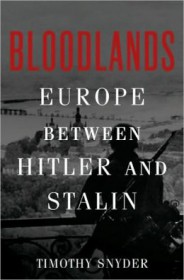 I can’t believe it’s been almost five years since the day I happened to catch Timothy Snyder speaking on Book TV about his then recently published book Bloodlands: Europe Between Hitler and Stalin. While watching Snyder deliver his lecture at New York City’s Ukrainian Institute of America I found myself completed captivated as he spoke at length of a region in Eastern Europe, when in the 30s and 40s, so many people died it boggles the imagination. So massive was this loss of life that Snyder dubbed it the “Bloodlands.”
I can’t believe it’s been almost five years since the day I happened to catch Timothy Snyder speaking on Book TV about his then recently published book Bloodlands: Europe Between Hitler and Stalin. While watching Snyder deliver his lecture at New York City’s Ukrainian Institute of America I found myself completed captivated as he spoke at length of a region in Eastern Europe, when in the 30s and 40s, so many people died it boggles the imagination. So massive was this loss of life that Snyder dubbed it the “Bloodlands.”
According to Snyder, roughly speaking this area stretches East of Berlin to West of Moscow, comprising what is now Poland, Ukraine, Belarus, Russia, and the Baltic republics of Latvia, Estonia and Lithuania. Within this region (closely corresponding to the border areas of pre-World War I Russia, Germany and Austria-Hungary) approximately 14 million people were deliberately murdered from 1933 to 1945. Almost all of them civilians (and a huge proportion of them women, children and the aged), they were systemically killed as a result of Nazi and Soviet policies. Compounding the tragedy, since this massive eradication of human life left so few survivors able to testify to the magnitude of this horror, and since these crimes against humanity occurred behind what would later become “the Iron Curtain”, it would take over 50 years and the fall of Communism before those in the West could finally comprehend the full scope and depth of this unimaginable modern horror. But now, with Snyder’s 2010 book Boodlands, we can finally begin to learn what really happened.
I received this book as a Christmas present several years ago but I’m embarrassed to say that I finally got around to reading it only a few weeks ago. However, like any excellent book once I went to work on it, I was sucked in like nobody’s business.
Not only does Bloodlands give Westerners a detailed and vivid look at the hidden horrors of the Eastern Front and the Stalinist nightmare that preceded it, but it also makes us look at World War II in a whole new light. With the glance at a map, one can easily see that Germany and European Russia border the Bloodlands, yet are not part of it. During the 30s and 40s both powers were ruthless dictatorships hell-bent on radically remaking this region as dictated by each regimes’ overarching political-economic blueprint. Therefore, by treating these Nazi and Soviet atrocities in the Bloodlands as two aspects of one single bloody quest for domination, Snyder takes a novel and bold approach to how we understand World War II, the Holocaust and Stalinist Russia.
Not only is Bloodlands well-written and well-conceived, it’s insanely well-researched. (According to Wikipedia, Snyder reads and/or speaks 11 European languages. This undoubtably helped him as he poured over archive material from Germany, Russia and Central Europe in creating this excellent book.) It’s also ideal to read alongside books like Keith Lowe’s Savage Continent: Europe in the Aftermath of World War II, Anne Applebaum’s Iron Curtain: The Crushing of Eastern Europe 1944-1956 and Catherine Merridale’s Ivan’s War: Life and Death in The Red Army 1939-1945. Like I said, this is an excellent book. I can easily see it making my Best Nonfiction of 2015 list come December.
Don’t get me wrong, this is a very grim book. But that should stop no one from reading it. Perhaps one of my favorite book bloggers said it best. Jean, on her blog Howling Frog Books called Bloodlands “the most unremittingly grim and tragic book I’ve ever read. That doesn’t mean you shouldn’t read it, because YOU SHOULD. But it won’t be fun.” Thanks, Jean. I could not agree more.
Hey, I knew you would like it. Now I just need to read Ivan’s War…
LikeLike
You were right! Now give Ivan’s War a chance. I doubt you will be disappointed.
Thanks for dropping by and commenting!!
LikeLike
Oh, I want to read it. It’s on my wishlist so I won’t forget. 🙂
LikeLike
I must read this. My dtr’s grandmother-in-law’s family was born in the “Stepp” and by the grace of God immigrated to the US early in the century. They lived in Colorado-then Nebraska. She was rather more like “My Antonia” than any of the poor folk in this book!
LikeLike
Excellent!
Please do read it! Thanks for dropping by my blog! Please visit again!!
LikeLike
Pingback: Immigrant Stories: The Train to Warsaw by Gwen Edelman | Maphead's Book Blog
Pingback: About Time I Read It: The Twilight Warriors by Robert Gandt | Maphead's Book Blog
Pingback: Nonfiction November Week 1: My Year in Nonfiction | Maphead's Book Blog
Pingback: 2015 In Review: My Favorite Nonfiction | Maphead's Book Blog
Pingback: Syrian Dust: Reporting from the Heart of the War by Francesca Borri | Maphead's Book Blog
Pingback: Five Bookish Links | Maphead's Book Blog
Pingback: Nonfiction November: My Year in Nonfiction | Maphead's Book Blog
Pingback: Focus on the Eastern Front: The Retreat by Michael Jones | Maphead's Book Blog
Pingback: Library Loot | Maphead's Book Blog
Pingback: Library Loot | Maphead's Book Blog
Pingback: Nonfiction November Week 2: Nonfiction and Fiction Pairings | Maphead's Book Blog
Pingback: A Reader’s Guide to Eastern Europe | Maphead's Book Blog
Pingback: Big Book Summer Challenge: Black Earth by Timothy Snyder | Maphead's Book Blog